Joy Neal Kidney's Blog, page 11
December 25, 2024
Free Kindle Read: The Cross and the Badge by William Ablan
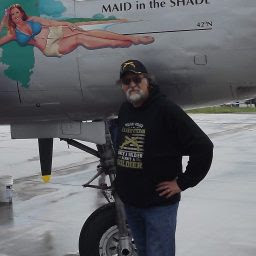

Right about now, someone is saying those immortal words, “There ain’t no such thing as a free lunch.”
There isn’t you know.
But for five days, starting Christmas Day and going through the 30th if December, and if you have a kindle account, you can read The Cross and the Badge for free. After that, it goes back to its regular price.
It’s, of course, a bit of marketing with hopes that if you like it, you might go out and purchase the other three novels.
So, let’s talk a little about The Cross and the Badge.
If there’s a single line that will describe the book, it’s the phrase, “Home ain’t home anymore.” Often times I’ve spoken of how veterans don’t always feel like they belong in the place they left. It’s a little like they left being a square peg, but they come back a round one. but everyone around them tries to make them fit back into the square hole.
Will Diaz will return from the Gulf War to a place he knows but seems to have changed. He’ll have a new job as a detective with a department he left years before. He’s going to mend fences with old friends, face new threats, and learn to anchor deep into his faith in God as he deals with the past and faces an uncertain future.
Hope you enjoy it, and Merry Christmas.
Click here for the kindle edition.
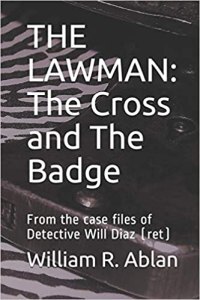 My thoughts: I’ll review the newest book in the Lawman series, From the case files of Undersheriff Will Diaz (ret.) soon: The Lawman–Event Horizon. This is a stand-alone novel but you’d enjoy it even more if you get acquainted with Will Diaz and his cast of lawmen, friends (childhood, Army days, townspeople, pastor), and family from the earlier books.
My thoughts: I’ll review the newest book in the Lawman series, From the case files of Undersheriff Will Diaz (ret.) soon: The Lawman–Event Horizon. This is a stand-alone novel but you’d enjoy it even more if you get acquainted with Will Diaz and his cast of lawmen, friends (childhood, Army days, townspeople, pastor), and family from the earlier books.
Faith and friendship weave through the nitty-gritty of police work. I was caught up in the authenticity and heart of this compelling story from the beginning. Don’t miss this!
December 21, 2024
Norfolk Island Pine
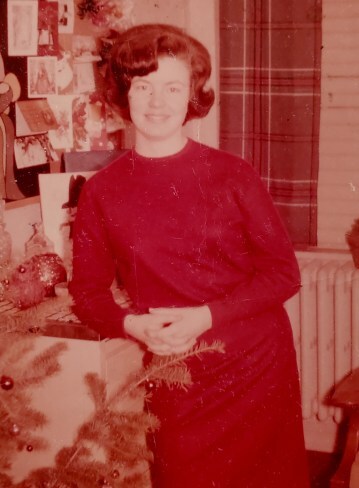 My dorm room, Lawther Hall, State College of Iowa, Cedar Falls, Iowa, December 1965. Taken by my boyfriend, yes, my Favorite Guy.
My dorm room, Lawther Hall, State College of Iowa, Cedar Falls, Iowa, December 1965. Taken by my boyfriend, yes, my Favorite Guy.You can just barely see it in the lower left of the photo, a Norfolk Island Pine, decorated for Christmas. (Noticing the radiator behind me, I can still hear the pipes clanging in the wall, Lawther Hall, State College of Iowa.)
Grandma Leora’s house was too small for a Christmas tree, so she started decorating a Norfolk Island Pine. It grew so large that it ended up in a corner of her entryway, where she added tinsel and baubles every Christmas.
As a college student, I also decorated a small Norfolk Island Pine. I have a feeling that Mom may have given it to me for just that reason. I haven’t had one for several years, but maybe I need another one. Nah, I’d have to water it and keep it alive. I did not inherit Grandma’s love of gardening, but I sure enjoy it as a fond memory.
December 19, 2024
Christmas 1936
Christmas 1936
Doris Wilson had graduated in May and was doing housework for Dr. and Mrs. Robert Osborn in Dexter, Iowa. Dale and Darlene were 15 years old and in 10th grade, Danny was 13, and Junior 11. The boys had been hunting with their dad, they wrote in letters to their older brothers who were in the Navy.
Delbert (age 21), still on the crew of the USS Chicago based in Southern California, had been home on leave the month before. He and his uncle, Willis Goff, rode as far as Omaha with a friend, visiting his Goff uncles while he was there. Clarence Goff was in the heating and cooling business, with two more Goff brothers working for him, making 60 cents an hour.
Not everyone during the Great Depression was struggling. Clarence drove his nephew Delbert and brother Willis to Dexter. In Dexter, Willis boarded a bus to Detroit to pick up a new Chrysler Royal touring sedan. Before driving it back to California, he drove his sister Leora and Delbert to Guthrie Center, where Willis had graduated in 1923. They had lunch at the Parrish Cafe (owned by Leora’s aunt and her husband), and talked to a former Dexter coach at the high school.
While still on leave, Delbert wrote Donald about enjoying Iowa’s clear cool weather and watching the Armistice Day football game at Redfield. Brother Dale played most of the game and Delb reported he was good at blocking. Delbert had been hunting with his dad and younger brothers “down Bear Creek,” chasing a fox and shooting two of the five squirrels they brought home for supper. He was hoping for a good tracking snow since “the fox are thicker’n flies in a cow barn when you’re milkin’ by hand.”
Donald (age 20, still in the navy) had been selected for a naval Electrical Interior Communications course on the East Coast. When the class was over, Don borrowed money from Delbert to come home on leave in time for Christmas, but by then, Delbert was back aboard their ship.
Clipping: The Sentinel, December 20, 1936–”Donald Wilson of Bellevue, D.C., came Sunday for a three week’s furlough from the navy in the parental Clabe Wilson home. When his vacation is completed he will go to the west coast, where he will again join his brother Delbert on the USS Chicago. Donald has been in the east for several months in school at Bellevue College, Washington, DC. “
 Donald was home from the Navy for Christmas 1936, Dexter, Iowa. L-R: Dale, Junior, Leora, Doris (who’d graduated that year from HS), Donald, Danny, and Clabe Wilson
Donald was home from the Navy for Christmas 1936, Dexter, Iowa. L-R: Dale, Junior, Leora, Doris (who’d graduated that year from HS), Donald, Danny, and Clabe WilsonYou may find more Depression Era stories of the Wilson family in Leora’s Dexter Stories: The Scarcity Years of the Great Depression.
December 18, 2024
National Twins Day: December 18
Ten babies were born to Clabe and Leora Wilson. Four of them were sets of fraternal twins.
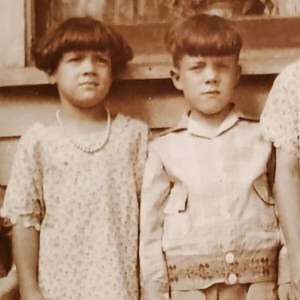 Twins Darlene and Dale Wilson, 1927, south of Dexter, Iowa
Twins Darlene and Dale Wilson, 1927, south of Dexter, IowaLeora already had three little ones by the time Dale and Darlene were born in Stuart, Iowa, in 1921. Two more singles were born before the next twins, Jack and Jean, arrived in Dexter in 1929. Jack and Jean were just infants when all nine Wilson youngsters came down with whooping cough. They were the only two who succumbed to the disease.
Grandma Leora said that she’d had miscarriages before both sets of twins. I believe the first time was a result of her suffering so during the influenza pandemic. So many who died of that pandemic were young parents. If a pregnant woman survived the influenza, her unborn child likely would not.

I couldn’t find any other twins in the family until I discovered that Clabe Wilson’s father (Daniel Ross Wilson) had a twin brother who didn’t survive. I’ve heard that twins tend to arrive every other generation.
Are there twins in your family?
December 17, 2024
There’s a Song in the Air
Do you have a favorite Christmas carol? You rarely hear my favorite one, probably because it covers quite a range of notes, making it difficult for most folks to sing.
The words were written by Josiah Holland, the founder of Scribner’s magazine, in 1872. While assembling a new Methodist Hymnal in1904, Karl P. Harrington, a Wesleyan University music professor, set the poem to music.
There’s a song in the air! There’s a star in the sky!
There’s a mother’s deep prayer and a baby’s low cry!
And the star rains its fire while the beautiful sing,
For the manger of Bethlehem cradles a King!
There’s a tumult of joy o’er the wonderful birth,
For the virgin’s sweet Boy is the Lord of the earth.
Ay! the star rains its fire while the beautiful sing,
For the manger of Bethlehem cradles a King!
In the light of that star lie the ages impearled;
And that song from afar has swept over the world.
Every hearth is aflame, and the beautiful sing
In the homes of the nations that Jesus is King!
We rejoice in the light, and we echo the song
That comes down through the night from the heavenly throng.
Ay! we shout to the lovely evangel they bring,
And we greet in His cradle our Savior and King!
By Josiah G. Holland, Public Domain
Click here to listen to a beautiful version.

December 13, 2024
I’ve been a Mom for 50 years!
Son Dan will be 50 on Friday the 13th of December. He was also born on a Friday the 13th, in 1974.
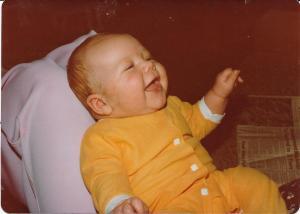 “What did we have?” I kept asking after being sedated for a C-section.
“What did we have?” I kept asking after being sedated for a C-section.
“I told you, a boy.”
“What do boys play with?” I’d grown up with one sister and several girl cousins.
A baby son, in Colorado. He was the only grandchild on either side, so there were soon heart tugs to return to Iowa, when we did when he was two years old.

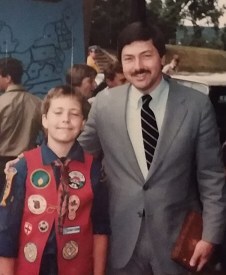 Meeting the national longest-serving governor, Terry Branstad, at a Scout activity.
Meeting the national longest-serving governor, Terry Branstad, at a Scout activity.The next couple of decades were filled with “adventures,” answering his notes to the Tooth Fairy, homemade Halloween costumes (Bilbo, Gandalf, Darth) volunteering for whatever he was involved in: school, AWANA at church, Cub Scouts (yes, a Den Mom), driving him to piano lessons and Boy Scouts, the first Star Wars movies and taekwondo, and to work at Target (until he got his license).
We hadn’t figured on parenting an only child, but I lost the next two pregnancies, so we are especially thankful for Dan! He and his wife Renee have a seven-year-old daughter, Kate. He works as a CPA (with a law degree) in the Twin Cities.
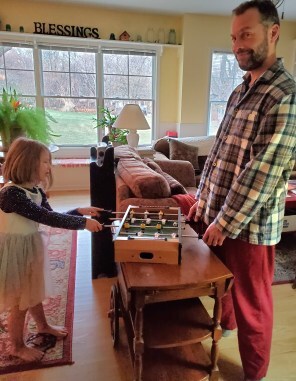 Dan’s parenting style. And they’re reading the Narnia books these days.
Dan’s parenting style. And they’re reading the Narnia books these days.What did boys play with, at least before Pac-Man? Dan’s favorite was Crossbows and Catapults.
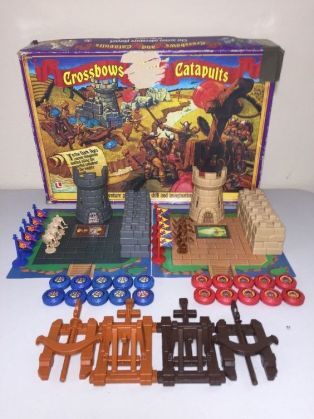
December 12, 2024
Christmas 1935 and hand-me-downs
During the Great Depression, brothers Del and Don Wilson were the best boys about writing home from the Navy. “We just couldn’t stand it very good if you didn’t. That’s the brightest ‘spot’ to us–you boys’ good letters,” their mother wrote toward the end of the second year of their enlistment, 1935.
Leora had mailed them a package of homemade divinity fudge, just like she had the Christmas before. The nuts in the candy were from “down on Jim Creek, south of the big spring where you boys got water when you were hunting squirrels,” their dad wrote. Black walnuts.
Men with sons in the Navy or CCC were cut off relief (welfare) jobs first, including their father Clabe, so he stayed busy trapping. He’d start out early by moonlight to check his traps, but was often disappointed. Only six skunks and five opossum so far that fall. He shipped eight skunk and five ‘possum pelts to Sears, writing to his sons that at least it’s a good healthy job. Clabe had sold their “roadster” a year earlier and they had no vehicle.
You may remember that earlier in the year, Clabe was desperate enough that he’d hiked into Dallas County asking farmers for work.
Clarence Goff was one of Leora’s younger brothers, one who was allowed to complete high school. His heating business in Omaha had doubled, and he expected the same for 1936. Clarence, or C.Z. as he was known, sent his sister’s family $10 for Christmas. Another brother, Wayne Goff, shipped a box of very welcome fruit from California, since Iowa in December is pretty colorless, the homeliest month of the year.
Willis Goff, another of Leora’s seven brothers, lived in Southern California, where the USS Chicago was based that winter. Willis and Ann invited Delbert and Donald to spend Christmas with them and their daughters, Connie and Shirley, who’d asked for a Shirley Temple doll for Christmas.
Leora took a photo for their “Navy boys” of the five kids at home on Christmas Day. Doris and Darlene look like the daughters in a well-to-do family, don’t they? Doris said she altered hand-me-down so no one would recognize who used to wear them.
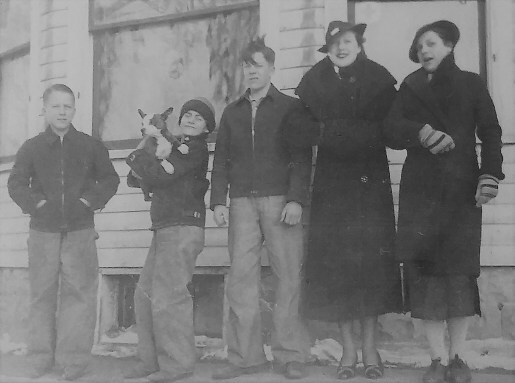 Christmas Day 1935: Dan, Junior with Spats, Dale, Doris, Darlene. Dexter, Iowa.
Christmas Day 1935: Dan, Junior with Spats, Dale, Doris, Darlene. Dexter, Iowa.You may find more Depression Era stories of the Wilson family in Leora’s Dexter Stories: The Scarcity Years of the Great Depression.
December 10, 2024
Sleighbells and Bobsleds
 Not the Goffs nor the Wilsons, but the photo does show the moveable runners under the bobsled box. Large bells on leather straps were added to the horses’ harnesses to jangle as the horses trotted. Oh!
Not the Goffs nor the Wilsons, but the photo does show the moveable runners under the bobsled box. Large bells on leather straps were added to the horses’ harnesses to jangle as the horses trotted. Oh!Christmas, Early 1900s
From the memoirs of Leora Goff Wilson: “We went [to our Jordan grandparents’ home near Monteith, Iowa] in a bobsled one Christmas. We put straw in, covered it with a blanket or two to sit on. As we went down the lane, Pa [Sherd Goff] says, ‘Look at the reindeer tracks, Santa’s reindeer.’ They were cow tracks, but we believed Santa was there. We were so thrilled and happy.
“I had hung my stocking on the back of a chair Christmas eve, but in the morning my stocking with a beautiful doll in it was on the cabinet close by. Mamma said, ‘Santa thought it might fall from the chair,’ so that was a good thing, I thought, for Santa to think of.”
That memory was from when Leora Goff was about ten years old. I hope sleigh bells were part of this scene, although she didn’t mention them.
Christmas 1924
Two dozen years later, Leora had married Clabe Wilson and had six children of her own by the Christmas of 1924. This is a memory of her oldest daughter, Doris, when the family lived southeast of Dexter, Iowa, where Clabe was a tenant farmer for B.C. Hemphill.
Christmas dinner was at Leora’s folks’ home in Dexter, about three miles away. Because of a nice snow the night before, Clabe filled Mr. Hemphill’s bobsled with hay to soften the ride. The bobsled was a wooden box with moveable runners, front and back. He hitched up a pair of horses and harnessed them with bells on leather straps.
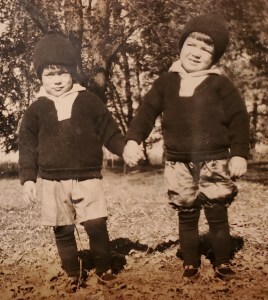 Dale and Darlene Wilson, age 3, November 1924, Dexter
Dale and Darlene Wilson, age 3, November 1924, DexterAll of the Wilsons bundled up, with the three younger children snuggled under quilts with their mother. Delbert (age 9), Donald (8), and Doris (6) stood up front by their dad, who held the reins. The delighted family glided over the snow to have Christmas dinner with Grandpa and Grandmother Goff, and the rest of the clan living with them in the small town of Dexter. Bells jangled, horses snorted frosty breaths.
Brothers Merl and Jennings Goff lived with their folks, along with Jennings’s two motherless children. Clarence Goff, a younger brother, was came from Omaha for the feast. Doris perched on the piano bench, she remembered. Grandfather found catalogs to boost the smaller children to better reach the table. Grandmother served squares of cheese on toothpicks, which was a new wonderful thing to the youngsters.
And oh, those sleighbells (listen) on their way home!
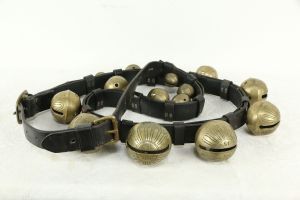 Sleighbells
Sleighbells
December 5, 2024
Christmas 1934: Leora’s Divinity Fudge
Clabe and Leora Wilson’s older sons joined the US Navy in early 1934. For Christmas that year, their mother mailed them a package, “so you’d have just a little from home for Christmas. Doris and I made some–I guess you can tell which kind–the divinity fudge I used to make and you boys used to like so well.” Leora didn’t have a candy thermometer nor electricity.
Clipping of the recipe in Leora’s small Memorandum book:
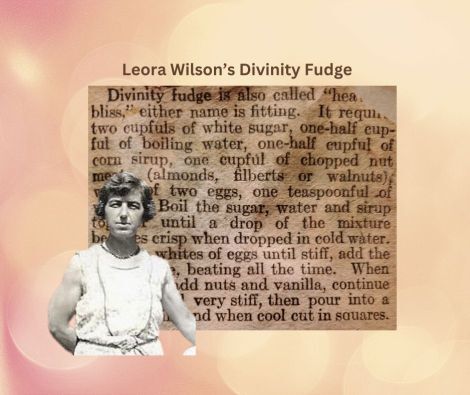
2 cups white sugar
1/2 cup boiling water
1/2 cup corn syrup
1 cup chopped nut meats (almonds, filberts or walnuts)
whites of two eggs
1 teaspoon vanilla
Boil the sugar, water and syrup together until a drop of the mixture becomes crisp when dropped in cold water. Beat the whites of eggs until stiff, Add the not mixture, beating all the time. When fairly stuff, add nuts and vanilla, continue beating until very stuff, then pour into a buttered tin. When cool, cut in squares.
The Wilsons gathered a lot of black walnuts in local wooded areas. Leora chopped some for her divinity fudge.
By the Christmas of 1934, Clabe had sold their Model T “roadster” (the one on the cover of Leora’s Dexter Stories). In fact, they had no automobile of any kind until they moved to Minburn five years later.
It was always a treat when Leora’s brother, Clarence Goff, came from Omaha. Their mother, Laura Goff, lived near the Wilsons, in a house that had electricity. That Christmas of 1934, Clarence brought his mother a dandy electric mixer, a box of candy, and an already-dressed turkey. He also brought a box of ‘kerchiefs for each of the “the girls,” a football for his nephew Merrill, a pound of Prince Albert and some “cough medicine” (alcohol) for Clabe and brothers Jennings and Merl, along with candy and nuts for everyone.
Clarence Goff, a 1923 graduate of Guthrie Center High School, had his own heating and cooling business in Omaha.
Neighbors O. S. and Nellie Neal gave the Wilsons a nice fat hen, which Leora served for Christmas dinner, along with potatoes and gravy, dressing, celery, Danny’s favorite cranberry sauce, pickles, fruitcake, and Clabe’s favorite lemon pie.
The Christmas of 1934, their Navy boys were blessed with plenty to eat (even without their mother’s divinity fudge), visits with aunts and uncles and cousins on the West Coast while their ship (USS Chicago) was in port there, and they were able to send a little money home. The younger five siblings–Doris, Darlene, Dale, Danny, and Junior–were thriving, doing well in school, enjoying winter activities.
Both Clabe and Leora came down with grippe, but all in all, things felt more hopeful that Christmas.
You may find more Depression Era stories about the family in Leora’s Dexter Stories: The Scarcity Years of the Great Depression.
December 3, 2024
Leora Wilson Celebrates 90th Birthday
 Leora with great granddaughters, Deni and Christa Scar
Leora with great granddaughters, Deni and Christa ScarMy mother and her sister (Doris and Darlene) held an open house in 1980 for their mother, Leora Goff Wilson, when she turned 90. Some of her great grandchildren were there to celebrate with the woman (born in Guthrie County, December 4, 1890) who had given birth to ten children, raised seven to adulthood, only to lose three during WWII.
Later she’d made a home in Guthrie Center for her own mother for fourteen years, then she lived alone for another two dozen years.
This is probably from the Guthrie Center newspaper:
Leora Wilson Celebrates 90th BirthdaySunday afternoon, Nov. 30, was a beautiful warm fall day, setting the scene for the celebration of the 90th birthday of Leora Wilson. The open house took place at the First Christian Church in Guthrie Center. The tea table was decorated with an arrangement of mums in rust, bronze and gold shades and Mrs. Wilson's daughters Darlene Scar and Doris Neal of Dexter presided at the serving.
Rev. Jerry Palmer gave a birthday blessing and a thank you to all who attended to honor this longtime Guthrian, formerly of Dexter. A table of photos were displayed of every years and the family. The surprise of the day was a gift from the children, grandchildren and great-grandchildren. A wall hanging compiled of quilt blocks sent from each one on paper and then transferred to material, painted then quilted by granddaughter Joy Kidney of West Des Moines. Gifts, cards, and phone calls from family members came from Colorado, California, Washington and Florida.
Ladies of the church helped in the kitchen to make the day possible and a memorable one. Others helping where granddaughters Gloria Neal and Chris Scar and greatgrandchildren Deni and Christa Scar and Dan Kidney.
Leora thoroughly enjoyed the afternoon visiting with 120 guests, family and friends from Earlham, Dexter, Stuart, Casey, Atlantic, Lake City, Guthrie Center, and Omaha, Nebr.
With Thursday, Dec. 4, the actual 90th birthday for Mrs. Wilson, she was with the Rebekah Lodge mending ladies at the Guthrie County Hospital doing their charity work. A courtesy was extended to Leora after the group completed their mending, and refreshments were served.
Mrs. Wilson has been mending there every week for 23 years, seldom missing the opportunity to share in the benevolent project sponsored by the Rebekahs.
 Each family member designed a quilt block. Aunt Darlene Scar used fabric paint to set each on fabric. I stitched everything together with fabrics that went with Grandma’s couch. Dan Scar now owns the 90th birthday wallhanging.
Each family member designed a quilt block. Aunt Darlene Scar used fabric paint to set each on fabric. I stitched everything together with fabrics that went with Grandma’s couch. Dan Scar now owns the 90th birthday wallhanging.What a delightful 90th birthday party!



